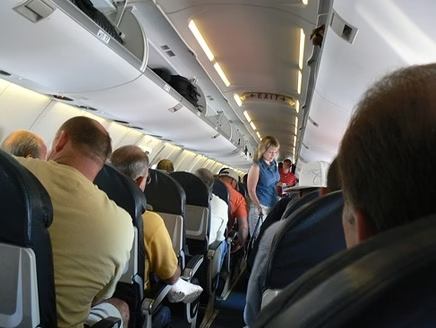Low airline seat pitch means more passengers on aircraft, slow emergency withdrawal, and more medical inflight issues.
Airlines launched their “basic coaches” or “infrastructure” configurations with low features and low legrooms. Now they are a little retreat, with this low-class service, a change in carry-on bags and flight is allowed. However, without changes due to the pitch of the low airline seat.
In the 2018 FAA bill, the Congress directed the FAA to conduct a study on a low airline seat pitch. Did new configurations of the aircraft sit, packing more and more passengers in aircraft, affected the aircraft withdrawal? Can the aircraft withdraw in 90 seconds, with half the door blocked? And, does the most common infiltration therapy make the emergency unconscious?
America is now waiting for the results of the study. As I understand it, FAA completed a part of the study. But the results have not been released after four years.
This week, the passenger advocates had a chance to talk to the DOT secretary for the first time, and they used to bring out the issue of seat size and emergency withdrawal. The only test focuses on the size of the seat. Nothing has been done on this issue during the Trump administration.
Advocates have been told that the size of the seat is different from the aircraft withdrawal tests. So, where are seat size tests? Advocates asked the supervisors of the tests and said that we could not inspect. Now, we want to hear public findings.
This is an example of a continuous consumer advocacy requirement.
Every day, behind the curtain, consumer advocates are difficult to work to improve travel. Travelers United has already learned that the complaints are not found anywhere to present the complaints as one of the customer comfort or passenger service. However, as a issue of health and safety sometimes dealing with a decreasing legroom can change. Another airline, along with the passenger rights group, is removing the problems of flyersight, travelers united inhuman seating. And now, three years later, Americans have no new reply from the government on the impact of the seat size on clearance. The deadline released by the Congress was October 2019. Here we are in 2024, still waiting.
The Chairman of the Travelers United changed the complaint for health and safety comfortably in the hearing of an advisory committee.
Arguments were made on the basis of health and safety, before the advisory committee for aviation consumer protection and before the Congress. They are being compromised due to low seat pitch. The arguments about space are no longer focused on customer comfort or passenger service. Today, logic focuses on safety and health.
, Security: Pacing more seats in aircraft is more difficult and taking time, thus less safe.
, Health: Tight seating means less movement for travelers, even while sitting, thus increases the incidence of deep-throne.
Both issues have been studied in the past by FAA and DOT. Both have been ignored by the FAA in its withdrawal testing and airline certification processes.
Airlines flirted with a health idea during long distance flights. Remember to exercise and bend on your seat to spread your back? When the seats were so closely squeezed together, they stopped that an average person can no longer bend on his airplane seat.
FAA has refused to test security and health on aircraft
When consumer groups asked the FAA to reconsider their rules on the seat pitch (distance from one seat to the next seat), they have been reprimanded. The FAA says that the ideas they used for the rule were ownership and they have no passenger health mandate.
It is not, Flowersrights.com argued. He won a case before the appeal of the US District Court for the Columbia district (USCA case #16-1101 document #1643380: 10/28/2016). However, the FAA has still not changed its rules. Today, airline consumers have a Congress mandate to test withdrawal and seating. However, the FAA is not doing its work.
As the airline seats are tight, the seats themselves become thin and less comfortable. In addition, the width of seats is narrowing as Americans, we will say, broad. Let’s face it, coach passengers are facing a squeeze that they have never experienced before in the history of aviation.
On the other hand, pets are protected by specific locations, food and water requirements. More dramatic with the difference between the aircraft human being Minimum space requirements should be made mandatory.
Also read: “Favorite seats” – How Airlines gets more money from you
Prisoners who sailing for Australia and Roman slaves had more legroom and seat pitch than today’s airline passengers.
In an article written almost a decade ago, I noted that slaves and prisoners today found more space than coach passengers. In those days, Britain was sending prisoners to Australia and the people of Rome were chasing slaves to their warships.
After a little research, I came to know that 250 years ago, prisoners sent from England to Australia were allotted a place of 18 inches per in prisoner.
Currently, according to sizeweise.com, most coach airline seats are only 17–18 inches wide.
In other words, passengers are flying from an MD-80, 727, 737, 737, 747-200, 747-200G, 747-400, 757, 767, MD-88, MD-90, CRJ-700, DC-9, DC-10, ERJ-10, ERJ or SAAB 340 SF3. First.
According to the historical record, Galli slaves also had a minimum 36 -inch seat pitch as well as 18 inch seat width.
Of course, no one would like to be chained for their wooden planks. But you get the idea. Even ancient societies had minimum standards for human cargo and their workers. This helped to improve the forced work and guaranteed that they could avoid traveling. The passengers paying today should expect at least that.
Lack of oxygen and lack of adequate movement are unconscious top medical information emergency
Finally, Travelers United published a story about “how to avoid passing the in-flight at 35,000 feet”. While researching the story, the author learned that fainting mantras are the most common intimate emergency on planes. The reason for these in-flight medical emergency conditions is tight seats with minimal legrooms. Nevertheless, even what is general knowledge for the flight crew and doctors, the FAA has not minimized these inflit medical emergency conditions.
Charlie Leoha is the chairman of Travelers United. He has been working in Washington, DC, with the stakeholders of the industry on Congress, Transport Department and travel issues over the last 14 years. He was the first consumer representative of the Advisory Committee for Aviation Conservative Safety appointed by the Transport Secretary from 2012 to 2018.



